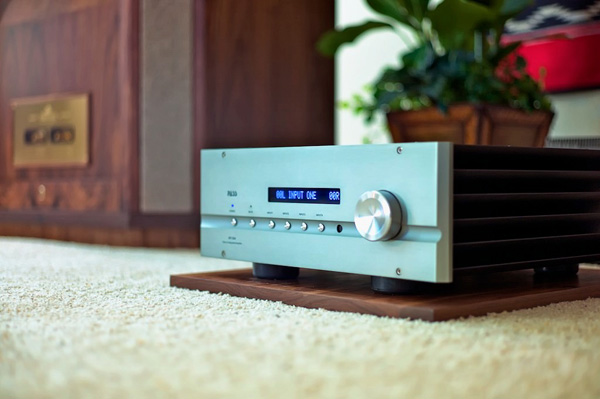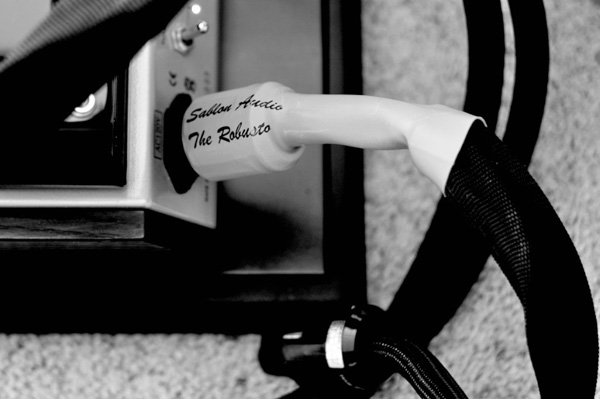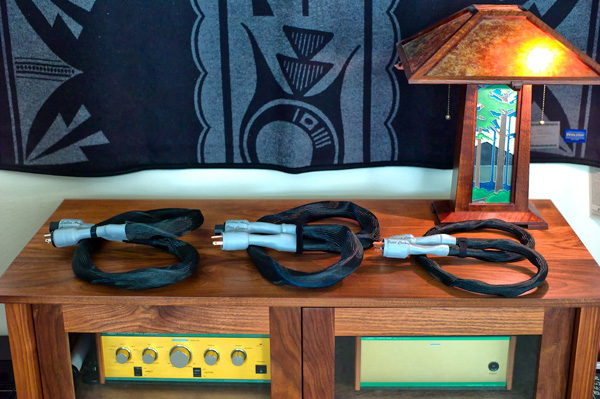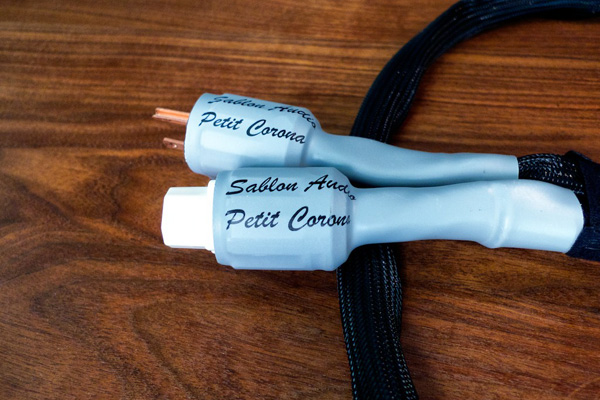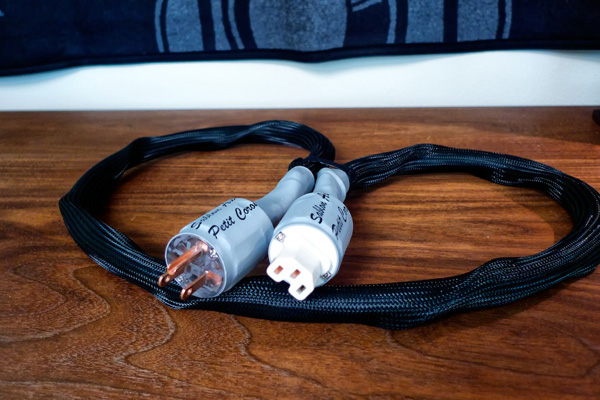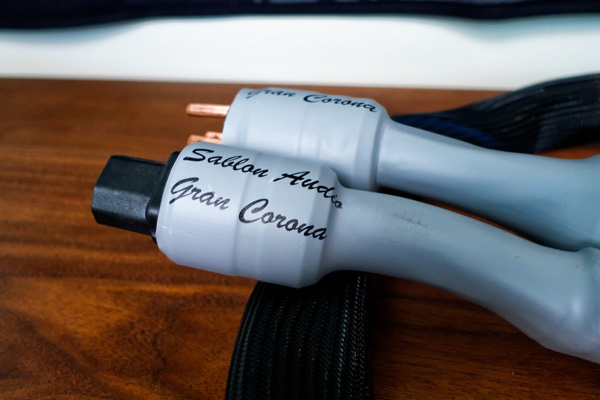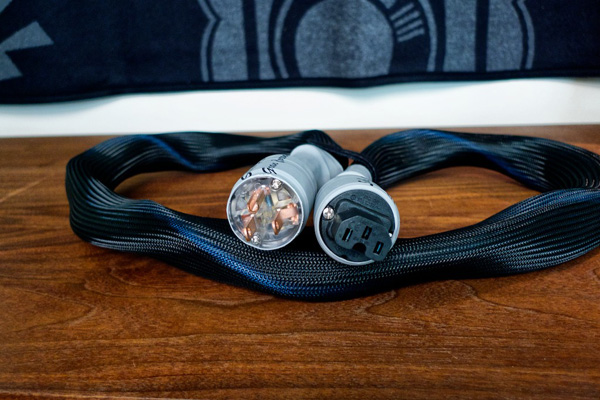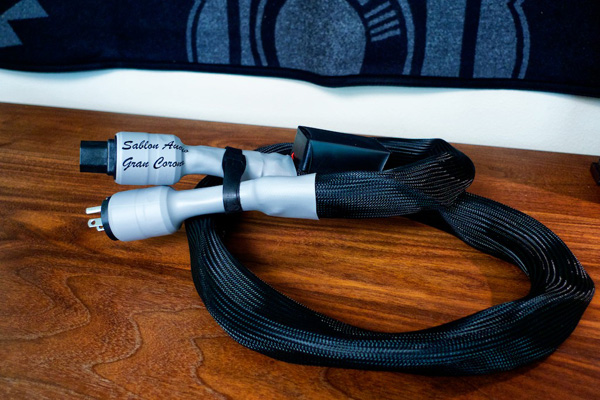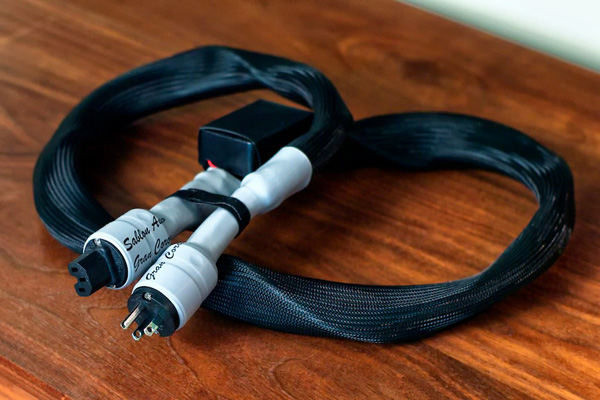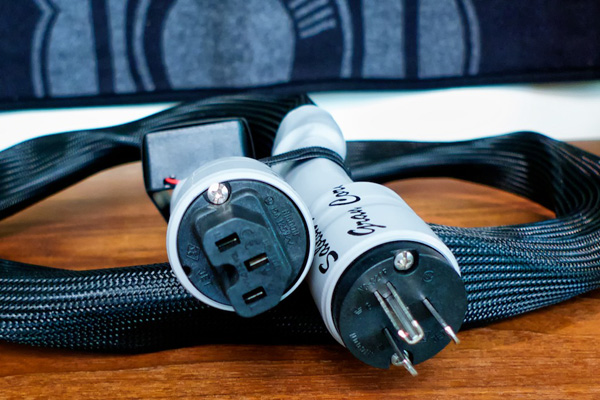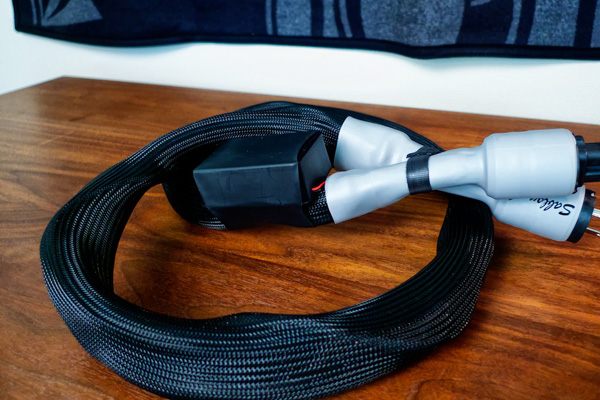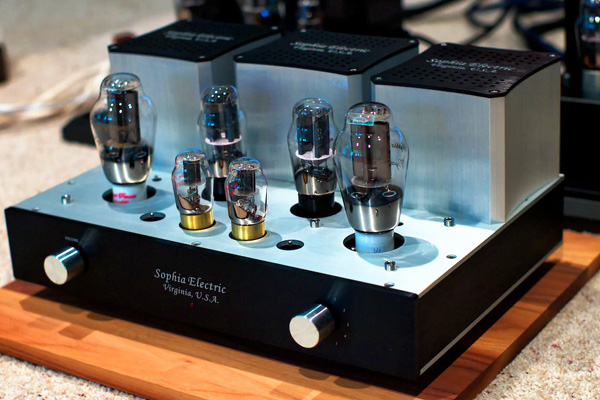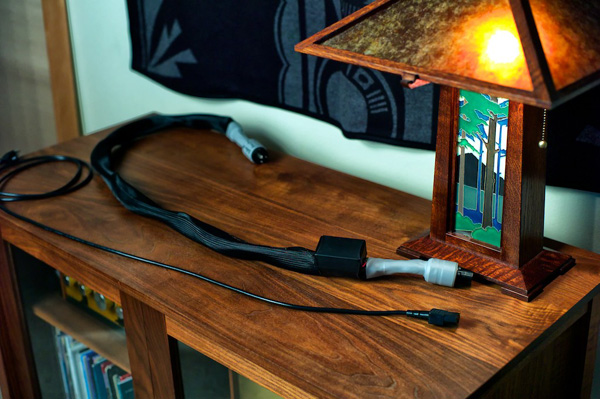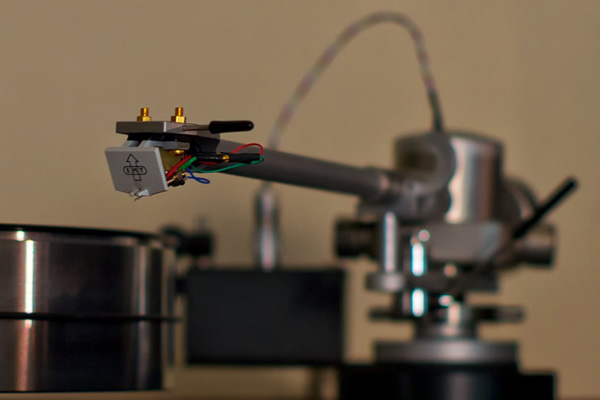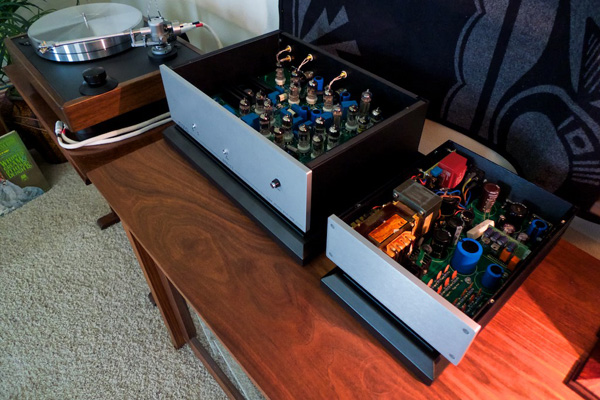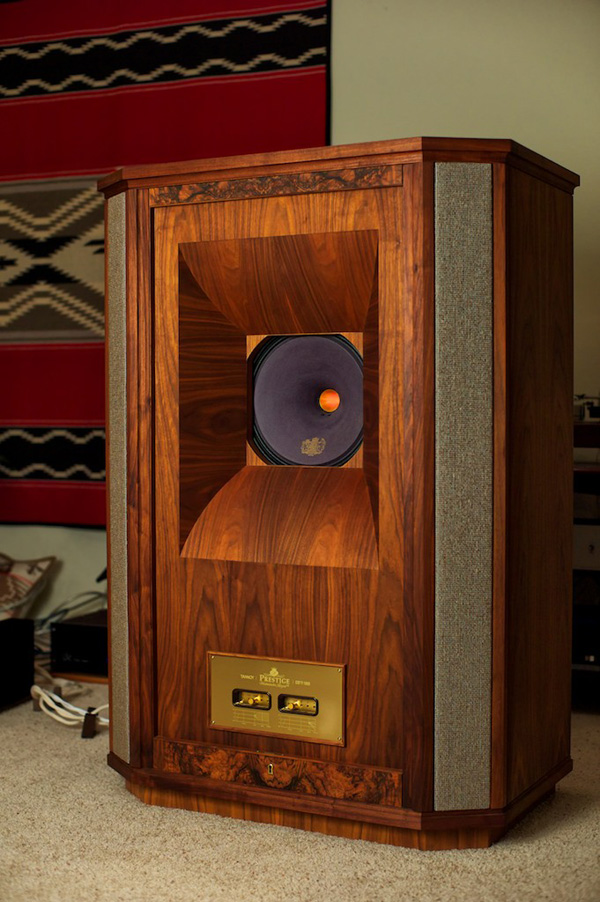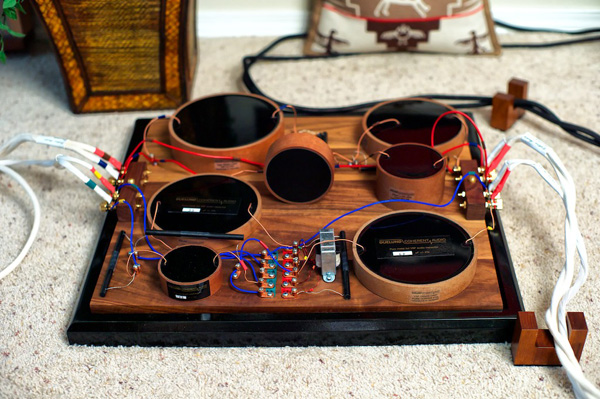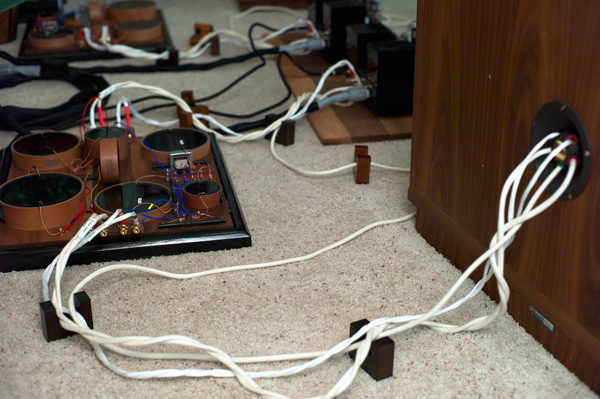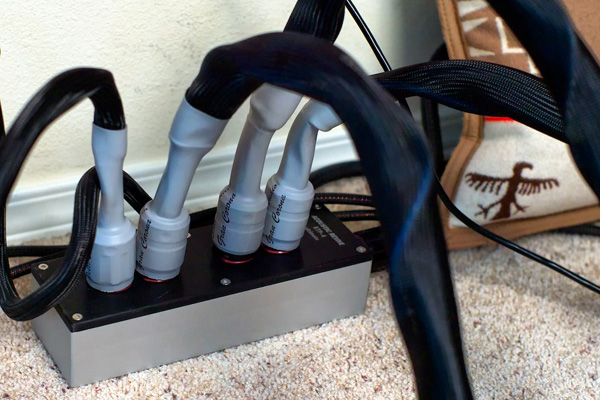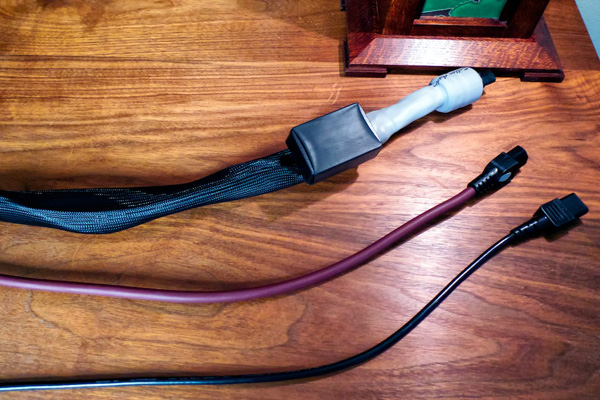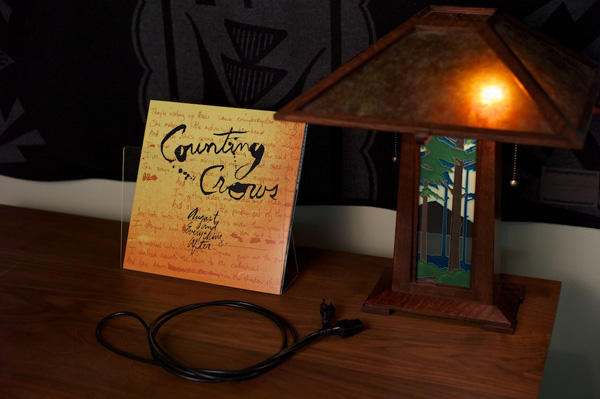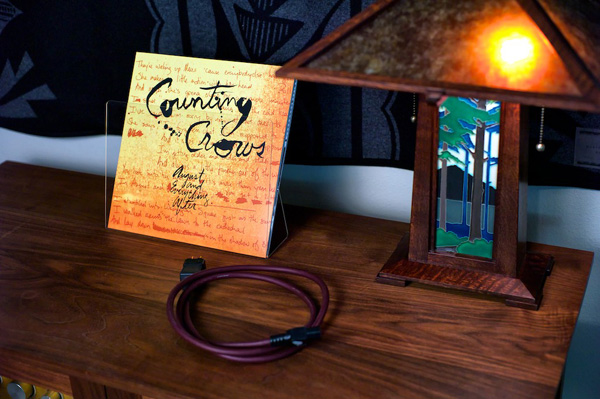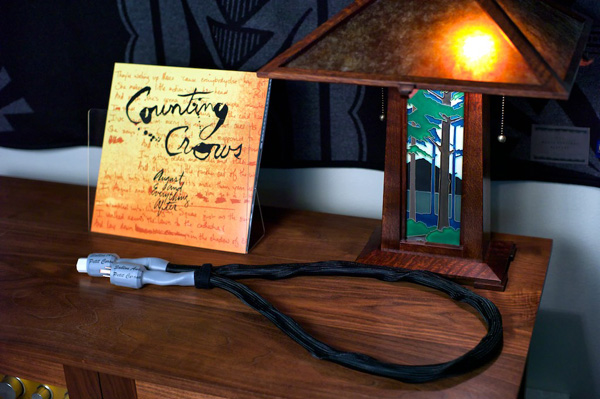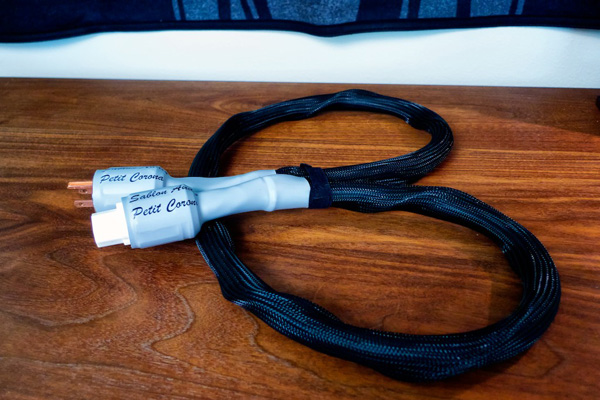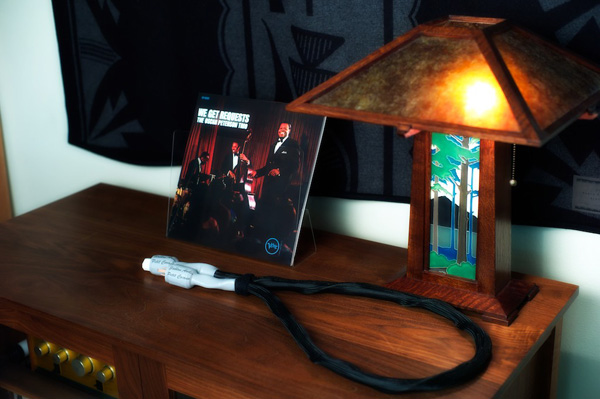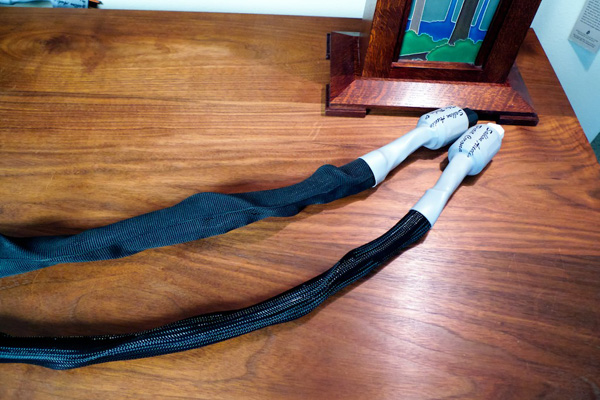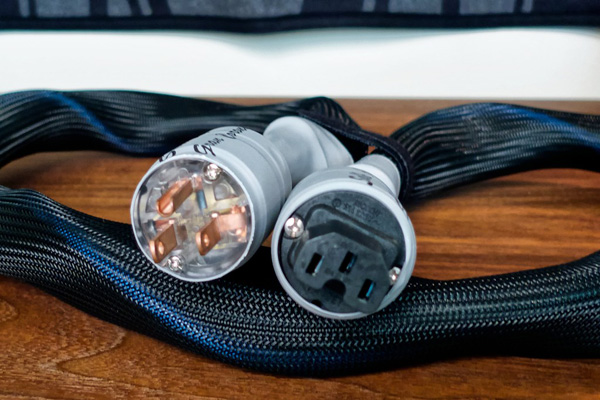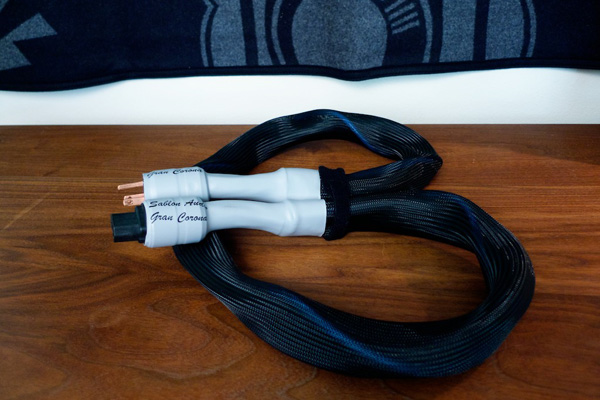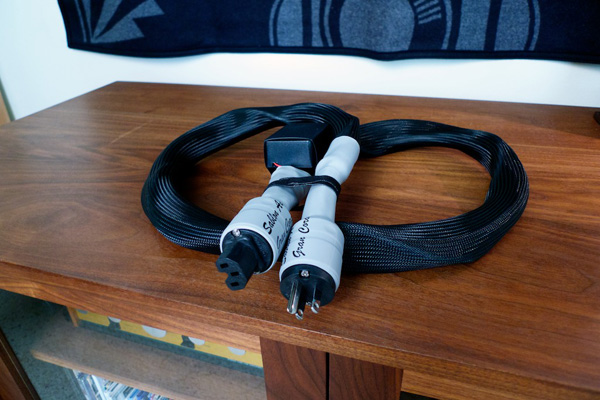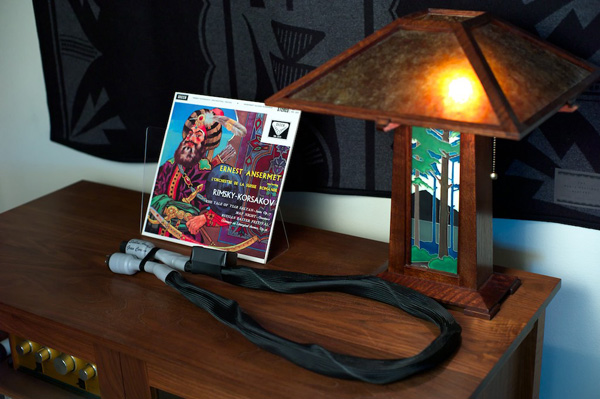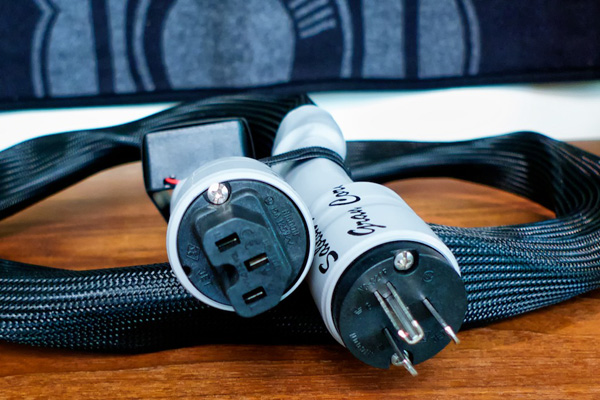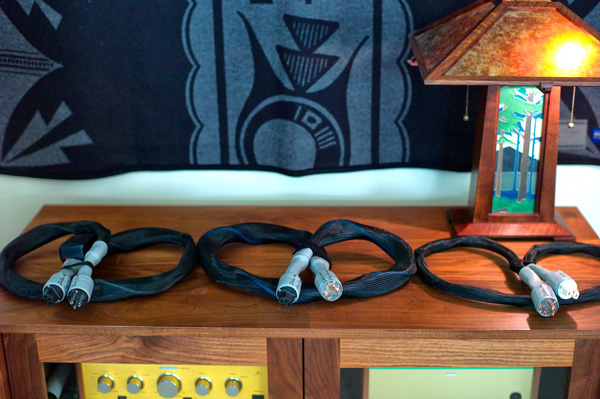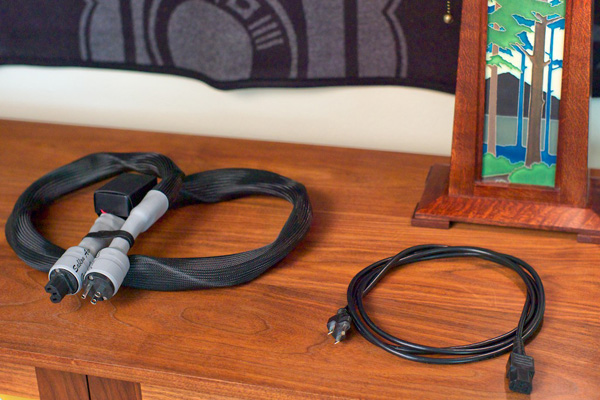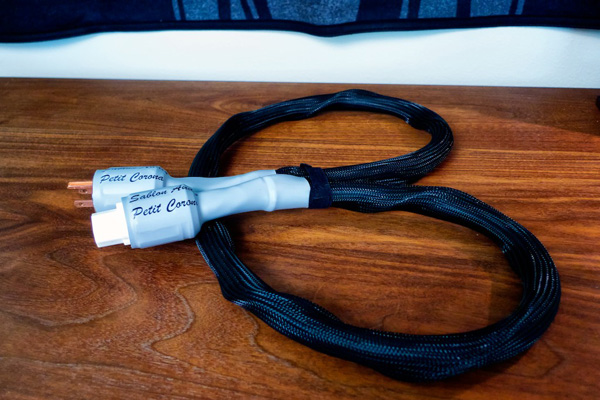|
You are reading the older HTML site
Positive Feedback ISSUE 68
Sablon Audio - The Corona Family of Power Cords: The
Petit Corona, the Gran Corona, and the Quantum Gran Corona
In my review of the Sablon Audio Robusto power cord in Issue 52 I told you about an experience Pete, Stephaen, and I had while playing Hi-Fi games with the Pass INT-30A integrated amplifier that Stephaen was reviewing for 6Moons back when. It's such a great story, and one that so beautifully illustrates how much of a difference a good AC power cord can make in a system, that it bears repeating as an introduction to this survey article about the Sablon Audio Corona family of power cords: "A while back Stephaen (6Moons) and Pete (Pete Riggle Audio Engineering) stopped by for some early morning coffee drinking and music listening, which I think is a mighty fine way to start a day. Stephaen brought along a Pass Labs' INT-30A solid-state integrated amplifier that he is reviewing for 6Moons. We plopped the Pass into my Review System #1 in place of my normal Leben RS100U preamplifier and CS660P power amplifier, then let its insides warm up while we warmed up our own insides with some freshly brewed Peet's coffee from the Jura Capresso. Our initial impressions with the Pass INT-30A in the system were mixed: it sounded reasonably pleasant, but a little uninspired compared to the Leben gear, and a little dry (as opposed to the Leben's tube liquidity). To see if I could help things along a little I decided to swap out the stock Pass power cord for one of the Acoustic Revive Power Reference power cords that I normally use in my system ($750 for a 2-meter power cord). Here's Pete's take on the results: "Had I been blindfolded I would have been able to guess that the Pass amp was a solid state unit when it was played with the stock power cord. Yes, it was dry in the midrange, and not fully enjoyable. The bass, which should have been superior to that of the Leben power amp, was maybe a little tighter and dryer, but not more enjoyable than the bass of the Leben. When the Pass amp was played with the Acoustic Revive power cord I would not have recognized it as the same amp played earlier with the stock power cord. Blindfolded, I would have identified it as an excellent tube amp with performance both evenhanded and holistic. When the Pass Labs amp was played with the Acoustic Revive power cord the midrange went from dry to lush. The bass went from non-musical to musical, and the tautness of the bass, to my senses, was an improvement to the system." If you've never heard the difference a really good power cord can make in a system, you're in for a nice surprise one of these days, just like Stephaen, Pete and I were in our listening session with the Pass and Acoustic Revive Power Reference cord, which brings me to the subject of this article, a new and impressive contender in ultra high-performance power cords, the Sablon Audio Robusto power cord."
I've been writing about the Sablon Audio custom cable products that are designed and handcrafted by Mark Coles in London, England, since the November/December 2010 timeframe of Issue 52. If you've been keeping track, you know I've been very impressed with what I've been hearing from Mark's power cord, interconnect, and speaker cable designs. Mark's artisan-level interconnects, speaker cables, and power cords are handmade using the very best techniques & materials. Mark has chosen every single aspect of his designs 'by ear' to achieve the best possible musical performance. Mark handcrafts each cable product in an incredibly labor-intensive process, which I have found to consistently provide impressive results.
When I wrote about the Robusto power cord back in Issue 52 I was really impressed with its performance, concluding that "The Sablon Audio Robusto power cord is a remarkable achievement in a power cord design, with performance that puts it right at the very top rung in the super power cord category, and for many, particularly those with equipment that is to the neutral or brighter side of life, it will come as a revelation in the way it improves overall musicality. Like its name implies, the Robusto is rich and full-bodied in its presentation of the music, with superb bass performance and dynamics. The Robusto performs remarkably well both sonically and musically, and particularly serves equipment well that needs to be nudged towards a fuller, richer, more dynamic sound." The Robusto power cord is still one of my all-time favorite power cords, and to this day the Robusto sees daily duties in my reference systems. The Robusto power cord is still available by special order ($675 USD), but the new Corona family of power cords represents Mark's core line of power cables now. The Corona Family of Power Cords Since I first wrote about the Robusto power cord in Issue 52 Mark has developed a full lineup of Corona power cords, which now includes the Petit Corona ($495 USD), the Gran Corona ($975 USD), and the newly released Quantum Gran Corona ($1300 USD).
All of the Corona power cords come in a standard length of 5-feet and are terminated with Type B 120V/60Hz power plugs and 15-amp IEC connectors for USA customers. The Gran Corona and Quantum Gran Corona are also available in 20-amp terminations upon request at no extra charge. For enthusiasts in other parts of the world, the Corona power cords can be ordered with Oyaide Schuko connectors for use in the European Union, or with Furutech connectors for use in Australia, New Zealand, and the United Kingdom (there is no additional termination charge for the Quantum Gran Corona, but there is a $75 up-charge for the Petit Corona & Gran Corona due to the extra cost of those plugs & connectors). (As a side note, for a handy reference that describes the plug types used around the world, visit the International Electrotechnical Commission website here.) In a very labor-intensive process, Mark applies a number of key techniques across his power cord range to maximize performance. Mark uses cryogenic treatment of the wire and connectors, an external counter wound ground line to minimize crosstalk from noise carried on the ground plane (augmented on the Quantum Gran Corona by the use of a shielded cable), and modified AC & IEC connectors that are high-performance hybrids created from combining and modifying components from more than one brand, rather than just utilizing matched pairs of stock connectors. Mark also applies Anti-Vibration Magic paint to key locations in his power cords. In similar fashion to the Acoustic Revive RAS-14 AC Power Conditioner I wrote about in Chapter 9 of the Acoustic Revive Chronicles (Issue 55), the Corona power cords also utilize noise-reducing crystals in critical locations to enhance performance. Mark uses different types of noise reduction crystals in the IEC and AC plugs, respectively, depending on the result he is trying to achieve. All of the Coronas feature a grounded design for safety, using an external lead to reduce noise interference. For Shindo owners Mark offers a special Shindo-optimized version that is both ungrounded for maximum S/N performance, and is also specially configured to work with Shindo power supplies. The reports from the field I have received from Shindo owners have been very positive about the performance enhancement realized from Mark's custom power cords. All of Mark's Corona power cords are tested for shorts and continuity upon completion, and then as a final touch they are conditioned on an Audiodharma Anniversary Cable Cooker™, so that they are already broken in before being shipped to a customer. I think that's pretty cool, because that way you can hear what you're paying for right out of the box. Here are the details for each of the Sablon Audio Corona power cords included in this survey: Petit Corona ($495 USD) The Petit Corona power cord is a recent entry into Sablon Audio lineup, and I know Mark is really excited about it. The Petit Corona provides a relatively cost-friendly entry into the Corona lineup of super power cords, and Mark says it's really an over-achiever. Mark feels that it performs at or above the level of the Robusto ($675 USD) by being more neutral, and by bringing the Corona-level of performance to a lower price point. I've included the Robusto in this comparison as a benchmark to give all you Robusto owners out there an idea of how the Corona power cords compare in the way they handle recorded sonics, musical fidelity, and their ability to provide an emotional connection to the music.
The Petit Corona utilizes 7 AWG / 10.5 mm2 runs of cryogenically treated copper wire per phase, a cryogenically treated high purity copper USA / NEMA AC plug, and a cryogenically treated 15 amp IEC. Mark says the Petit Corona "has been carefully tuned to flesh out impact and scale." As I pointed out earlier, Mark's attention to detail in extracting every last bit of performance out of his designs is impressive, and he uses noise reducing crystals in critical locations of the Petit Corona to give "greater detail and dynamic range" just as he does in his most expensive designs. About the Petit Corona, Mark says, "There is an excellent level of micro-detail, a linear presentation across the frequency range and realistic tonal presentation with a very low noise floor for this price point."
The smaller gauge of the wire also gives the Petit Corona more flexibility (literally) than its larger stable mates, which makes it "easier to use in cramped spaces where large diameter or stiff cords may be difficult to accommodate." Gran Corona ($975 USD) Compared to the Petit Corona, Mark says the extra money you spend on the Gran Corona buys you more of everything sonically: "The lows go lower, the highs higher. Soundstage is deeper, taller and wider. Dynamics become more emphatic. Noise-floor is lower still; bringing forth all that micro-level ambient information that imbues life to hi-fi systems."
I reviewed the original Gran Corona in the March/April 2012 Issue 60. I said about the Gran Corona then that "The bottom line is this: prepare to be impressed, as the Sablon Audio Gran Corona is the real deal. The Gran Corona incorporates every technological refinement extant into its tour de force design. In a hand assembled, labor and tweak intensive process, Mark, through very careful and astute listening, has created in the Gran Corona a superbly musical and sonically spectacular AC power cord. The Gran Corona unfailingly delivered a musically evocative and emotionally charged listening experience that I enjoyed coming back to time and time again. A smokin' hot Gran Corona—way to go Mark!" Since that time Mark has continued to refine the Gran Corona, and he says he has realized a significant performance increase by using a modified Oyaide C-004 IEC connector. Mark says, "This gives a wonderful increase in performance across the board, with clarity, dynamics and sound-staging being notably improved." Mark says the new Gran Corona with the modified Oyaide connector offers 40% more performance than the earlier version. I've got both the original and new Gran Corona with the modified Oyaide connector, so it was interesting to do a little back-to-back listening during the review to hear how much difference adding in the Oyaide IEC made. It's hard to tell the two connectors apart visually, as they are very similar in appearance, but if you look closely at the IEC plug end, the platinum plated Oyaide C004 IEC has a CE marking visible. (see photo below)
The Gran Corona uses 4 AWG / 21 mm2 of cryogenically treated copper wires per phase, with cryogenically treated high purity copper USA / NEMA AC plugs, and cryogenically treated modified Oyaide C-004 Platinum / Palladium plated beryllium copper 15-amp IEC connectors. (Mark also offers upgrade services for your original Gran Coronas to the new Oyaide connectors should you want to do that) Mark selectively applies Anti-Vibration Magic paint to the Gran Corona, which he says helps control resonances, and as a result it increases focus. I think its pretty cool that Mark practices the philosophy of continuous improvement for his cable products. You can be sure that if Mark comes across something that really makes a meaningful performance difference that he'll be incorporating it into his cables. I also think its pretty cool that when Mark comes across a new discovery—like his cryogenically treated and modified Oyaide C-004 Platinum/Palladium plated beryllium copper 15-amp IEC connectors—he makes it available to his customers as an upgrade, which protects their original investment. What a great business model! Quantum Gran Corona ($1300 USD) The Quantum Gran Corona ($1300 USD) is Mark's statement power cord. The Quantum Gran Corona includes everything described above for the Gran Corona, while also adding an active Quantum Resonant Technology noise reduction circuit, and an enhanced grounding implementation of a shielded external counter wound ground line that minimizes crosstalk from noise carried on the ground plane. You can see the Quantum box behind the IEC plug in the photo below.
According to the QRT website, their proprietary circuitry reduces EMF noise & RFI interference on the mains waveform without limiting voltage swing or altering the impedance of the AC supply. QRT says their technology provides a measurably "lower noise floor, greater clarity and separation and increased dynamic range."
Mark told me that within the Hi-Fi industry there are a number of manufacturers that incorporate Quantum Resonant Technology into their products (although not all off them disclose that fact). Among those that do are Nordost, Reimyo, HiFi Tuning / Kemp, Walker Audio, and Russ Andrews. Mark says, "I source my modules directly from Quantum so it is not beyond the realms of possibility that others use the exact same item in their implementations."
Mark says, "The performance benefits are that this cord has become even clearer, dynamically stronger and more extended at both ends of the frequency range. This iteration moves the game on even further than the earlier Oyaide IEC update!"
Mark says an upgrade program for existing Gran Corona owners is available. Contact Mark for details. The Review Methodology For this Corona cable survey I tried to reproduce the same sort of situation that Pete, Stephaen, and I experienced back in 2010 with the Pass INT-30A integrated amplifier. The Pass INT-30A integrated amplifier is of course long gone now, but I have a Sophia Electric 91-03 300B vacuum tube integrated amplifier here that is in for review, and I thought it could play that role nicely.
By setting up a review system with minimal electronics and changing only the power cord on the integrated amplifier, it provides a really clear view of the performance envelope of a power cord, as Pete, Stephaen, and I found out in 2010. It also provides an idea of just what magnitude of change you can expect from inserting just a single power cord. You don't have to invest in a power cord for every component in your Hi-Fi rig to hear what I'm talking about, as all the references in this article are to the results of changing out the single power cord on the integrated amplifier. The effect of putting a good power cord on all your components is significant, however, but you don't have to do that to hear what I'm talking about. One question that always comes up from fellow audio enthusiasts is how big the magnitude of change in performance is from the product in question. Is the change so subtle that only a trained golden eared-listener can hear the differences after multiple comparisons? Or is the change so obvious that any member of the general public can hear it over the din of a dinner party? I'll try to address that question in detail as I go through my listening impressions with these individual power cords, but suffice it to say that the magnitude of the change you'll hear from one of these ‘super cords' compared to a generic OEM power cord is huge. The difference I heard was at least as big as I hear going from a $500 USD power amplifier to a $10,000 USD amplifier (or more)—it's a big change. While at first blush it may seem crazy to spend $500, a $1000, or even more for a custom power cord, it turns out that a custom power cord may actually represent one of the larger bang-for-the-buck changes you can make in your Hi-Fi rig. "Hmm… $500 for a custom power cord or $10K for a new amp for the same magnitude of improvement… what should I do?" I have to admit that until I had heard these ‘super' power cords in my own system—first from Acoustic Revive, and now from Sablon Audio—I fell into that camp that thought power cords didn't make that much of a difference, and to spend serious money on them was crazy. Now I know better.
Chances are that you have no idea how good your equipment really is until a good custom power cord has unleashed its potential. Whether your amplifier is a solid-state device from a Zen-Master amplifier builder like Nelson Pass, or a valve art wonder from one of the Wise Men of the East, the stock generic power cord that comes with your gear is probably choking the life out of it compared to what it is capable of with a custom power cord. At least that's what Stephaen, Pete, and I experienced while experimenting with power cords, and I suspect you're in for the same sort of treat should you venture further into the custom power cord realm. Over the years as my audio reviewing methodology has evolved, I have found that it is useful to break out my listening impressions into three areas of evaluation: audiophile-style sonics, musical attributes, and the emotional connection to the music. I consider audiophile sonics to be those non-musical attributes captured during the recording process like transparency, soundstaging, imaging, soundspace, and resolution, etc., that can add a little spice to the recorded music listening experience. The musical attributes that are captured on recordings are normally considered to be timbre, melody, harmony, rhythm, dynamics, tempo, and loudness, which represent the fundamentals of music making. Then there's that third category of performance of a component's ability to create an emotional connection with the music, and that's a little harder to pin down and articulate because you feel it as much as hear it. I'd like to think that if a component does a credible job of having high fidelity to the musical attributes of timbre, melody, harmony, rhythm, dynamics, tempo, and loudness, as you hear in a live performance, and was sprinkled with just the right amount of audiophile sonic seasoning by an artful designer, then the result would be emotionally engaging. Yet it is not always the case that a high level of emotional involvement results from a component that is sonically superb and has high-fidelity from a musical standpoint, so there's more going on with the emotional involvement aspect of Hi-Fi gear than one might assume. As such, I do my best to characterize the sonics, the musical fidelity, and report on the level of emotional involvement I am experiencing from a given component to try to give you the best picture of its performance envelope as possible. The Review System
To gather listening impressions for the Corona power cord survey I used my usual front-end combination of an EMT TSD-15 phono cartridge mounted on a VPI Classic turntable. For phono equalization I used the superb New Valve Order SPA-II, with the output going directly to afore mentioned Sophia Electric 91-03 300B vacuum tube integrated amplifier that is in for review.
For loudspeakers I used my usual reference Tannoy Westminster Royal SE loudspeakers.
I recently bypassed and replaced the stock crossovers of my Tannoy Westminster Royal SE loudspeakers with the absolutely amazing Duelund CAST external crossovers developed during the Duelund-WRSE Project that I have been chronicling on my blog here, and which I will be writing a feature article about in the coming months for Positive Feedback—stay tuned!
I'm using the Sablon Audio Panatela component speaker cables supported with Acoustic Revive RCI-3 Cable Insulators. I am also using a full set of Panatela component speaker cables as the internal wiring for my WRSEs as part of the Duelund-WRSE Project. The Panatelas are connected directly to the Dual Concentric drivers inside the Westminsters, then routed down and out through the cabinets to connect directly to the Duelund CAST external crossovers. This approach eliminates all of the sonically degrading internal connections within the Westminsters, providing an ultra-pure and uninterrupted Panatela signal path direct from the Duelund CAST external crossover to the WRSE's Dual Concentric driver. That combined with the aforementioned Panatela component speaker cable set from the amplifiers to the Duelund external crossover makes for a complete Panatela signal path from amplifier to the Dual Concentric driver.
I used Sablon Audio Panatela interconnects from my turntable to the New Valve Order SPA II phono stage, and from the NVO to the Sophia Electric 91-03 300B integrated amplifier I used a long run of Acoustic Revive Single Core interconnects (in for review). A Sablon Audio Petit Corona power cord was used to connect the NVO SPA-II phono equalizer to an Acoustic Revive RPT-2 Ultimate Power Distributor for AC power, which was in turn connected to a wall outlet with an Acoustic Revive Power Reference AC power cord.
To allow for direct comparisons of the power cords I had each AC power cord plugged into the four-outlet Acoustic Revive RPT-4 Ultimate Power Distributor for AC power. This allowed me to make quick and equivalent changes of power cords providing AC to the Sophia Electric 91-03 integrated amplifier for comparison purposes, making for a really nice way to compare power cords. Listening Impressions In this article I'll characterize the performance of the Corona family of power cords so you can get an idea of what to expect from them in your Hi-Fi system: the Petit Corona, the Gran Corona(s) (both the older rhodium plated version and the newer version with a palladium/platinum plated beryllium copper Oyaide 004 IEC connector), and the Quantum Gran Corona. I want you to be able to get a feel for the magnitude of change these power cords are capable of, so to kick off the listening impressions I have included a generic power cord (about $5 USD) that's typical of those that come stock with Hi-Fi components, to serve as a baseline.
For another data point I've included the twenty-times as expensive Furutech G-320Ag-18, which is a good $100 power cord. I've also included the Robusto ($675 USD) power cord to give those who own the Robusto an idea of where it falls on the performance spectrum compared to the Corona family of power cords. From top to bottom in the photo above is the Quantum Gran Corona power cord, the Furutech power cord, and the generic power cord. Over the review period I listened to a lot of different music with all these power cords, so I'll first generalize on their performance to give you an overall feel of their performance envelope, and along the way I'll pick out a few specific examples of music to highlight some of the important aspects of their performance. I'll discuss the generic & Furutech power cords first as a baseline of comparison, then I'll move on to specifics with the Sablon Audio power cords. Generic Power Cord First of all, the generic power cord was nothing to write home about sonically, with subpar soundstage depth, width, and height, and very little sense of a soundspace in the recording. It had sort of a grey tinged overall presentation that was both murky and a little gritty sounding (i.e. poor transparency & resolution), with imaging that was flat and two-dimensional. Musically the generic power cord fared better, however, having a decent sense of tempo, rhythm, and melody. However, the timbre was bleached and grey, and lacked the rich textures and deeply infused tone colors that I like to hear in my recorded music listening experiences. From an emotional connection to the music standpoint, the generic power cord fared better than I had expected given its sonics & timbral belly flops. What saves it is a lively sense of tempo, rhythm, and melody, which helps makes the music fun to listen to.
The generic power cord pretty much choked the life out of the new 45-RPM Analogue Productions remastered version of Counting Crows' August and Everything After. If you listened to the Crows' album with only the generic power cord you'd think Chad Kassem and the boys at Analogue Productions had ripped you off, because the generic made it sound grey, gritty, sibilant, compressed, and just generally uninspiring. I love the Crows' music so I could still tap my foot and such, but knowing what a truly wonderful job Chad & the boys did on this album it was painful to hear it reduced to such a bleak two-dimensional experience. I don't think anyone would go out and buy one of these generic power cords for their performance, but I can see why most manufacturers include them, as they're a cheap giveaway for you to power up your new toy with. The analogy that I was reminded of while listening was that the generic power cord was like the ‘snowy' old black & white television set of my youth. I enjoyed watching those ‘snowy' old B&W television shows on it with Mom & Dad & Bobby because that was all we had back then, but they sure don't compare to watching Blu-ray movies on a 1080P LCD screen where even the old B&W films look great! Would I go out and buy a vintage B&W TV instead of a new hi-resolution color screen? Not! While not everyone will be pleased to hear it, that B&W tube television versus a 1080P color LCD television was the same sort of difference in performance that I heard between the generic and high-performance power cords. Welcome to the 21st Century! The Furutech G-320Ag-18 Next up was the Furutech G-320Ag-18, which is a good $100 power cord. The Furutech pretty much slaughtered the generic power cord. It added a dose of naturalness to the music that fleshed out timbral textures and tonal colors, putting some flesh & blood on those musical bones. The soundstage opened up and gained width and depth, and images gained a little bit of a sense of space around them. I wouldn't say that the Furutech lent an overall sense of ambient space to the recording, as the soundspace was pretty much missing in action. While the Furutech was more transparent than the generic power cord, it wasn't all that transparent in a true ‘super' power cord sense, as it still sounded a bit muffled by comparison. The Furutech also had an average level of resolution by comparison, and there were some significant musical details that were missing in action.
When you're used to hearing true high-performance power cords like those from Sablon Audio or Acoustic Revive it's pretty hard to get excited about the Furutech. From an emotional involvement standpoint, the Furutech's performance was similar to the generic power cord. The Furutech bested the generic power cord in the way it reproduced the sonic & musical elements of recordings, with August and Everything After beginning to give me a hint of what I paid for when I bought the premium Analogue Productions 45-RPM version of this album. The Furutech was much better than the generic power cord, and if you've only got a $100 to spend on a power cord you really can't go wrong. But make no mistake, the Furutech didn't even come close to the performance level of a true high-performance power cord in letting me hear the musical potential that lay hidden in my Hi-Fi equipment and recorded music. The Petit Corona ($495 USD) The Furutech is $100 USD and the Petit Corona is $495 USD, so it's only fair to ask the question "Is the Petit Corona five times better than the Furutech?" No, actually it isn't. It's more like ten times better. Or twenty times better. When I put the Petit Corona into my system in place of the Furutech it was really quite a shock as to how much more performance it offered. With the Furutech I couldn't get a good sense of the soundspace on August and Everything After, but with the Petit Corona a huge billowing soundspace emerged to encompass my listening room. Like I said, the difference shocked me, and I have to say I'm normally pretty immune to being shocked after all these years of writing about audio.
With the Petit Corona the soundstage also opened up dramatically, with big increases in width, and with instruments imaging well outside the speakers' positions. The depth of the soundstage increases, and there was a noticeable layering of images into its depth, which truly impressed me coming from the Furutech's limited depth and layering ability. Imaging had a body and presence to it with the Petit Corona that the Furutech just could not touch. Does that mean the Furutech is a bad power cord? No. It's a great power cord for $100 USD, but the Petit Corona was just in another league. The Petit Corona not only did a great job on the non-musical sonic attributes like transparency, soundstaging, imaging, soundspace, and resolution that are captured on a recording, but it also did a great job on fidelity to the musical information captured on a recording. Timbre had absolutely gorgeous textures, beautiful tonal color, and a sense of natural decay of musical notes on August and Everything After that were completely lost with the Furutech. Those motional attributes of music like melody, rhythm, and tempo come through beautifully with the Petit Corona, lending the sort of excitement and emotive stimulation that made the music come alive in my listening room for a truly emotionally engaging listening experience.
The Petit Corona provides a rich musical listening experience for the music lover. On August and Everything After it sounded a little bit dark and rich, threw a huge sense of space, had absolutely gorgeous timbral textures and tone colors, and a bit of natural warmth that made it quite addictive to listen to. Sonically the Petit Corona is quite impressive, over performing in its ability to make magic come out of those non-musical recording attributes like transparency, soundstaging, imaging, soundspace, and resolution. The Petit Corona seemed evenly balanced from the lowest lows of my West's to their highest highs, and it played at natural levels without strain. Most importantly, the Petit Corona always drew me into the musical message, which at the end of the day is the most important attribute for me of all. On the Analogue Productions 45-RPM reissue of We Get Requests (Verve V6-8606) by The Oscar Peterson Trio, overall the Petit Corona sounded rich, a little bit dark, relaxed, and easy on the ears. The Petit Corona's was an easy to enjoy style of presentation. The Petit's bass was punchy sounding, which gave a nice sense of rhythm and forward momentum. Timbre was really nice too, being both tonally colorful and texturally rich. Ed Thigpen's triangle had a sparkle and presence about it that reminded me of the real thing, and Ray Brown's bass playing sounded really true to life. With the Petit it was easy to pick each of the instruments out of the mix.
I would have liked to hear just a touch more sparkle on the piano, and a touch more mid-level dynamics in the melody line (like I did with the Robusto). The Petit Corona provides beautiful sound quality, giving that late-night listening allure to music listening sessions even in the afternoon. The imaging of the Petit Corona I found to be very good, with all of the instruments separated out distinctly in width and depth over the soundstage. Resolution of the Petit Corona was also good, being just a touch shy of what I'm used to hearing with the Robusto. Overall the Petit Corona provides a superbly musical presentation, making music accessible and enjoyable over the long haul. The Petit Corona is a worthy competitor to the Robusto, being nearly as musically astute and enjoyable, while being more balanced top to bottom. If you've never experienced what a truly high-performance power cord can do for your Hi-Fi system, I can't think of a better place to start than with a Petit Corona. Even one Petit Corona can transform the music playing ability of your Hi-Fi. In fact, all of the listening impressions for this article were describing just the one power cord I changed on the amplifier—that's it, nothing more. Honestly, I can't think of a single improvement to your Hi-Fi that will be greater in magnitude for the cost involved than a Petit Corona power cord. For $495 USD the Petit Corona has the ability to transform your system for the good, and that's a big deal. The Robusto ($675 USD) (see review in Issue 52) As I mentioned earlier, Mark feels that the Petit Corona is really an over-achiever in a power cable design, and that it performs at or above the level of the Robusto by being more neutral, and by bringing the Corona-level of performance to a lower price point. As I promised earlier, even though this survey is primarily about the Corona family of power cables, I thought I should include the Robusto in this comparison as a benchmark to give all you owners out there an idea of how it compares to the Petit Corona.
When listening to August and Everything After I thought the Robusto was more transparent than the Petit Corona, and that it resolved more low-level musical information than the Petit. The Robusto was not as evenly balanced from top to bottom as the Petit, having a bit more bass emphasis, but depending on your speakers, you may like that attribute of the Robusto. Even with my Westminster Royal SEs' 18-Hertz bass extension I only rarely found the extra bass of the Robusto to be intrusive. After listening to Oscar Peterson's We Get Requests with the Robusto my first reaction was "Man that's nice!" The Robusto presented We Get Requests with a rich, dark, detailed, clear, colorful, and naturally warm presentation that was the aural equivalent of having a warm kiss blown in your ear. It's true, the bass of the Robusto is accented somewhat, but timbrally I thought it was more truthful to the way an upright bass sounds than the Petit Corona, which made Ray's bass sound a little tighter and more controlled than I'm used to hearing in life. Ray's bass is a little bit sloppy sounding with the Robusto, while still having superb momentum (just like in life). The Robusto is also very adept at the rhythmic & melodic presentation, whether it was Ray Brown on bass or Oscar Peterson on piano, the Robusto makes the rhythm and melody lines come alive! This will probably drive Mark crazy when I say it, but I think the Robusto is probably the most timbrally correct of all the Sablon Audio power cords. Not by much, but by a little (with one caveat which I'll discuss a bit later). The Robusto is certainly a music lover's favorite, especially if you need a little extra oomph in your bass. The Robusto is not as transparent as the Gran Corona or the Quantum Gran Corona, but it is more transparent than the Petit Corona. The Robusto may be Mark's first power cord, but its still one of my favorites. The Robusto does a superb job on melody, rhythm, and tempo, which made it easy for me to establish an emotional connection to the music as the Robusto carried me along on the emphasis of the flow of the notes. The Robusto is also exceptionally musical in the truest sense of the word, it really does a great job of conveying timbre, melody, harmony, rhythm, dynamics, tempo, and loudness—those fundamentals of music making that are encoded on recordings. Is the Robusto at $675 USD better than the $495 USD Petit Corona? That depends. If you value the Petit's evenly balanced top to bottom voicing, then the Petit's probably the AC power cord for you. If your tastes run to a richer and more robust presentation, well then, I think you'd like the Robusto. The Robusto was extremely musical and provided a high level of emotional engagement with the music. I think the Robusto is a notch up from the Petit Corona that's consistent with its extra cost, besting the Petit Corona by a little bit across the board: musically, sonically, and from an emotional engagement standpoint. The Gran Corona ($975 USD) Since I had an original Gran Corona here with the rhodium connector (see review in Issue 60), I thought I'd compare it to the new Gran Corona that uses a modified Oyaide C-004 platinum/palladium plated beryllium copper 15-amp IEC connector, so those of you who have one of the originals will know how it stacks up in case you want to take advantage of Mark's offer to upgrade your original Gran Corona.
Listening to Oscar Peterson's We Get Requests with the original rhodium Gran Corona, I thought it was more transparent & resolving than the Petit Corona, and with more sense of space evident. Interestingly, the Gran Corona also sounded louder to me at the same volume setting than did the Petit Corona. The Gran Corona also had more bass punch. The images on the soundstage were bigger and more visceral with the Gran Corona over the Petit Corona. By analogy it's the same sort of difference that you get when going from a 50mm lens (the Gran Corona) on your camera to a 35mm lens (the Petit Corona). A 50mm lens puts you a couple of feet closer to the image, and so does the Gran Corona. The melody line is more dynamic and lively with the Gran Corona, and tempos (and changes in tempos) are more evident. The Gran Corona places you a couple of steps closer to the musicians, provides more soundstage depth, and it is more transparent in general allowing you to hear deeper into the recording. With the Gran Corona the decay of notes trails off longer, giving a dreamy late-night quality to We Get Requests. The original Gran Corona provides good sonics, good musical fidelity, and a nice level of emotional engagement. As I was listening to different albums I thought, "It doesn't get much better than this."
Then I put on the new Gran Corona with the modified Oyaide C-004 platinum/palladium plated beryllium copper 15-amp IEC connector. Well… I guess it does get better than the original Gran Corona! The new Gran Corona with the Oyaide IEC was more natural sounding than the rhodium Gran Corona (something I always value), and the timbre was closer to reality both in texture and tone color. The new Gran Corona with the Oyaide connector had a clarity, richness, and natural warmth that I found really appealing. The new Oyaide Gran Corona was much more musically natural, while still retaining all of the detail resolution and high performance sonics of the earlier version (or even bettering it). The Oyaide Gran Corona was also more liquid sounding, with tempos flowing along more naturally, with melodies being more naturally lifelike and exciting to hear. I am surprised that the modified Oyaide 004 IEC makes such a big difference in musicality, and it shifts the Gran Corona's overall balance towards a much more musically natural presentation, while still retaining or improving upon the high level of sonic prowess of the old Gran Corona. If you've got the original Gran Corona this is a no brainer of an upgrade, and it's an easily audible improvement across the board. The new Gran Corona is so good that it makes the Petit Corona sound a little veiled and dynamically challenged in comparison, which by any absolute measure it certainly is not. The Oyaide Gran Corona scores very high on its sonic performance, has beautiful musical fidelity, and it provides a very high level of emotional engagement, all while giving an expansive view of the musical performance that ‘breathes' with life and naturalness. I'm really impressed. The Quantum Gran Corona ($1300 USD) The Quantum Gran Corona had more detail, more space, and more air around instruments than the standard Gran Corona when listening to We Get Requests. The Quantum Gran Corona also had noticeably better dynamic presentation across the range from micro to macro. The Quantum Gran Corona was also quite a lot more transparent than the standard Gran Corona, with details coming through in the recording that I couldn't even hear with the Petit or Gran Corona. The Quantum Gran Corona does all of this while maintaining most (but not all) of the Oyaide Gran Corona's musicality.
While the Quantum Gran Corona offers higher performance from a sonics standpoint, I didn't think it did quite as well on the musical attributes of recordings as did the standard Oyaide Gran Corona. On small group jazz like We Get Requests I found instrumental timbre to suffer a little in comparison to the Oyaide Gran Corona. What I heard was an aural equivalent of what happens with a digital photograph in post-processing when you crank up structure definition a little bit too much. It looks impressive, but it doesn't really look very natural or true to life. That's the equivalent of what I hear with the Quantum technology, there is a loss of natural musicality on smaller scale music that I find a little disconcerting. The Quantum technology seems also to accent high frequencies a little more, so there's more shimmer on cymbals, for example, and it emphasizes that first strike on percussion. Strictly speaking, the sonics are improved quite a lot in the audiophile sense of things, but I thought fidelity to the musical attributes of recordings actually went down a notch (with one exception that I'll discuss in a moment). The result is that I get less emotional connection to the music with the addition of the Quantum technology. To maintain a proper perspective on this, the Quantum Gran Corona is a still a very musical and natural sounding power cord, but just not quite to the extent that the standard Gran Corona is.
Now about that exception I wanted to mention related to the Quantum Gran Corona: I'm not sure why, but when it comes to larger and more complex musical performances, like those of classical music, what bothered me about the Quantum Gran Corona with smaller group music went away—poof!—and I actually preferred its performance to that of the non-Quantum Gran Corona. For example, when listening to Ernest Ansermet conducting L'Orchestre de la Suisse Romande on the Speakers Corner reissue of Rimsky-Korsakov The Tale of Tsar Saltan (et alia), I thought that the Quantum Gran Corona was clearly better on classical music than was the Gran Corona. The Quantum Gran Corona's high resolution and clarity allowed me to hear all the instruments, and it presented them with a smooth and natural soundscape that was really flattering to classical music. I know that sounds a little contradictory, which makes me feel a little circumspect in mentioning it, but that's what I heard, so that's what I'm reporting. The Quantum Gran Corona's lively melody lines, great portrayal of tempo, and superlative dynamics from micro to macro only further enhance the classical music listening experience. If your listening is primarily classical music you should give the Quantum Gran Corona serious consideration.
Now that I've broached the subject of classical music, let me talk about the Petit Corona, the Robusto, and the Gran Corona a little more. I found that the Robusto was not quite as magical on Tsar Saltan as it was on Oscar Peterson, but the Robusto was still very musically engaging on classical music. The Petit Corona was similar to the Robusto in its performance on classical music, but sounded a little more homogenous, and a little mellower, which I thought was a plus on Tsar Saltan, where the strings can get a little piercing at times. But still, the Petit Corona had a nice, musically engaging presentation on classical music, and one that I preferred to the Robusto's presentation. There is no question in my mind that the Oyaide Gran Corona is better on classical music than both the Petit Corona and the Robusto. It's extra resolution, clarity, and smooth and natural musicality made for an enticing musical presentation of the orchestra. Of all the Sablon Audio power cords I've found the Oyaide version of the Gran Corona to be the best ‘all around' power cord in the Sablon Audio lineup, playing jazz, classical, and anything else you throw at it with a convincing musicality that always gave me a nice, strong, emotional connection to the music. If you listen primarily to classical music then the Quantum Gran Corona becomes the power cord of choice. Summary & Conclusions Mark Coles says on his Sablon Audio website that, "All Corona power cords offer a grain-free and effortlessly musical presentation, with expansive soundstaging. Voicing, especially with the copper AC plug, is to the slightly warm side of neutral with detailed yet non-fatiguing high frequencies. Bass is extended and solid, with full and natural tonal reproduction. An extremely low noise floor captures hitherto unheard ambient details."
I'd say Mark's is an accurate description of the performance of the Corona family of power cords from Sablon Audio. However, what Mark doesn't say is just how large the magnitude of change one of his high-performance Corona power cords provides over a generic power cord—it's huge. There's at least as large of a change going from a generic power cord to a Sablon Audio Corona power cord as there is in going from a $400 USD amplifier to a $10,000 USD amplifier.
Given the overall performance improvement that even a single Sablon Audio Corona power cord made in my system, I think they really have to be considered as an audio component in their own right. I've come to the conclusion that generic power cords strangle the potential of high-performance audio electronics to such a degree that you'll never have any idea of what your investment in equipment and music has bought you until you unleash their potential with a capable power cord providing the AC. Your equipment and recordings are probably a lot better than you think they are, and for a lot of high-performance Hi-Fi gear there's performance potential just under the surface waiting to be released. On a scale of one to ten I would rate the generic power cord at a one at most, the Furutech at a two or three, and I would cluster the Sablon Audio Coronas around nine, ten, and eleven! The Sablon Audio power cord that will best meet your needs will depend on your budget, your associated audio equipment, the direction you want to move your system in, and your own personal taste.
All of the Sablon Audio Corona power cords are a huge step up from an ordinary power cord, so you can't really go wrong whichever one you choose. If you're on a budget or are a little timid about sticking your toe in the power cord water, then you could try the Petit Corona at $495 USD. Just buy one and put it on your amplifier and prepare to be surprised. I thought the Petit Co |


